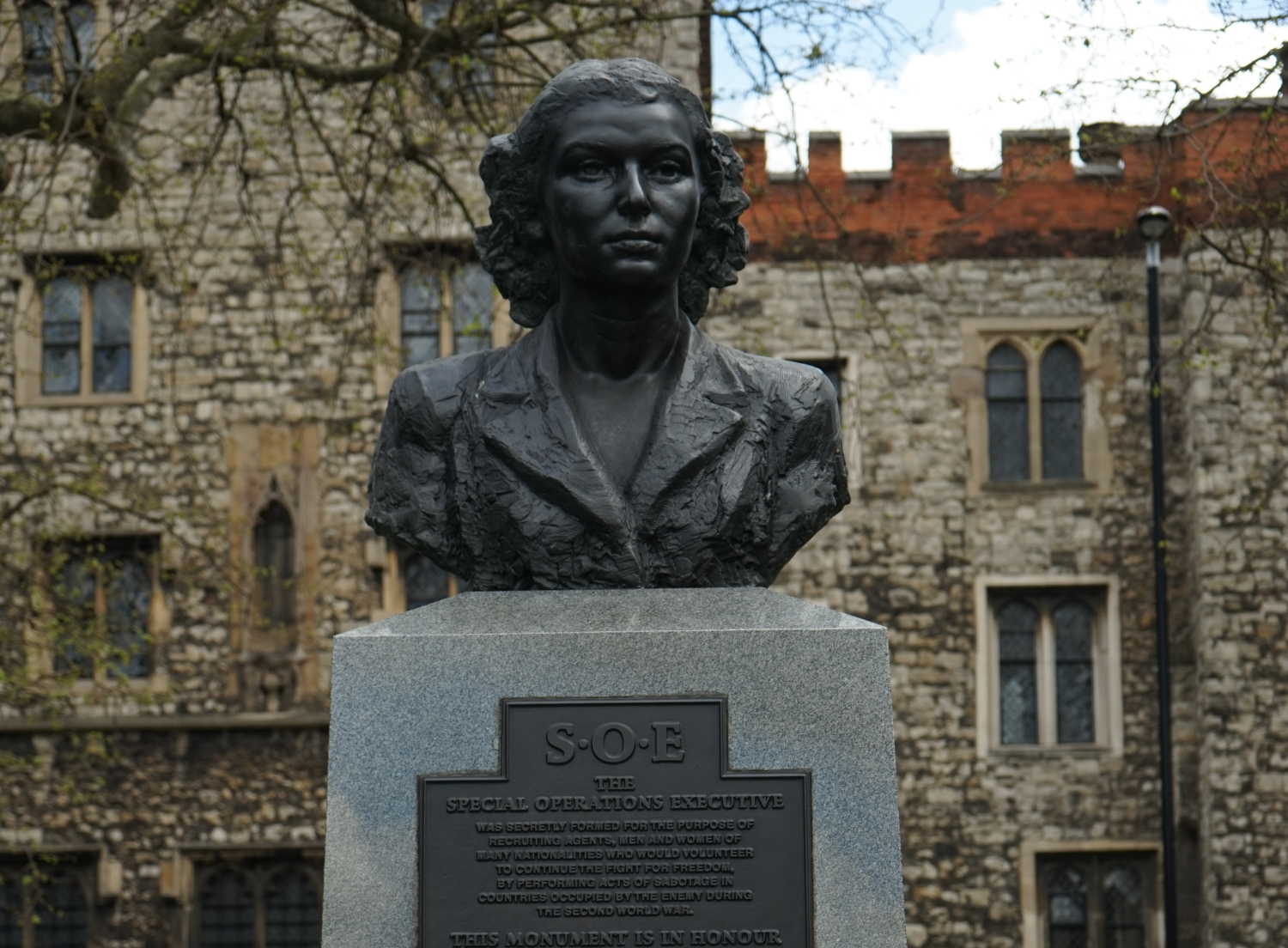
Teachers’ Guide for Secret Liberators: Canada’s SOE Agents in Occupied France.
John Myers OISE (retired)
Section 4 Sample Lessons
The above strategies serve as lessons or parts of lessons to be used with the Secret Liberators. Here are 4 stand-alone lessons or parts of lessons that can be used during or after the film. Each sample has three parts: minds on, action, and consolidation or before, during, and after (or similar). Minds on is like a warm-up to the lesson. Action is where students learn the new concept. Consolidation is where we take our new learning and summarize it/practice.
Sample 1- Women in the SOE
While the SOE agents interviewed and extensively referred to in Secret Liberators are men, there are also references to the important role female agents played. This lesson allows students to explore some of these people further.
Minds on- Before showing Secret Liberators ask students to hypothesize the roles female agents might have played in the war.
Action- During the film student note the roles the women featured below (Yolande Beekman, Noor Inayat Khan and Yvonne Rudellat performed as SOE members
Consolidation- Have students compare what they learned about the above agents to what they hypothesized about the roles women agents played using the I used to think…. Now I think…. Visible thinking routine.
Extension1 (of 2)- To students, state the following: “Your mission is to learn more about these and other female agents and their work during World War 2.
Yolande Beekman

Noor Inayat Khan
Yvonne Rudellat
Extension 2 Erika Jarvis in the November 25, 2016, of Vanity Fair wrote an interesting article: “Five Badass Female Spies Who Deserve Their Own World War II Movie”. Have students find the article online and in a class or small group discussion have them decide if Erika is right.
NOVEMBER 25, 201
Sample 2- Tech in War
The museums in the U.S. and the U.K. noted in the World of Spies themes section have descriptions of the many technical innovations invented or popularized in WW2: from coding and weaponry to radar to penicillin.
Minds on- Have students recall the role of technology in World War 1 and debate which technology made the biggest impact in the war.
Action- During Secret Liberators have student note of all the technologies used.
Consolidation- Have students debate which technology made the biggest impact in the war.
Extension Hedy Lamarr was a famous actress in the 1930s
But she was also an inventor. Your mission is to find out what she invented and how it influenced events in World War 2.
Sample 2a Coding in the SOE
“In War-time, truth is so precious that she must always be attended by a bodyguard of lies.” Winston Churchill.
Much of the technology featured above deals with communication and the need to code messages so that the enemy could not figure out what was going on. One famous example from World War Two was the Enigma coding machine used by the Nazis to communicate with its various military operators. Secret Liberators identifies some of the communication tricks used in the war and the ways the Nazis used the “radio game” to counter the work of the SOE. While there were many ways to disguise messages so that the enemy could not figure out their meaning, we shall focus on Morse Code, named after Samuel Morse, one of its inventors. It was developed along with the telegraph in the first half of the 1800s. Until the end of the 20th century it was the dominant system for armies, ships trains, and airplanes to communicate. Morse Code was a crucial communications tool in World War 2. While other systems have come to take over the world of coding even today some in the military still learn to use it.
This section and advice for other aspects of the teachers’ guide comes from work with Jennifer Legare, special education teacher in the Peel District School Board. Much of her teacher career has been with non-academic students. She found that the world of spies was a hit with her students and she focused on this beyond what history teachers normally do. Among the things her classes did were learning about different spies, take on different personas and tested by an interviewer (her vice-principal) to see if they’d stay in character. They learned Morse code and made light bulb Morse code machines using batteries and flashlight bulbs. The unit would end with a secret mission that required them to solve all kinds of clues and mysteries, find secret drops, or other spies (staff) and end with a pizza party at the end. To quote Jennifer: “It was always the best and most fun week”
Minds on- During the film have student note all the ways agents communicated with London and each other.
Action- Teach them Morse Code: the oldest continuous code used from 1844 to almost 2000. It is still taught to some servicemen and women today.
Here is the code and its translation into English.
Here is a sample message courtesy of Jennifer including instructions for students.
Consolidation- Have the class figure out the following message.
____ ____ ____ ____
_ _ . _ _ _ _ _ _ _ ..
____ ____ ____ ____ ____ ____ ____
_ _ _ _ _ . _ . _ . .. _ . _ ..
____ ____ ____ ____ ____ ____ ____ ___
. … _ . . _ . ._ . . _ _ _ _. .
Extension- Charles “Checker” Tomkins represents an aspect of coding unknown to many. Your mission is to find out what and who he represented and how it influenced events in World War 2. Here is a place to start https://www.thecanadianencyclopedia.ca/en/article/indigenous-peoples-and-the-first-world-war
Sample 3- Coping with Heroism
The popular movie and TV portrayal of spies does not often show the complexities of human behaviour. Secret Liberators offers insights into the real world of espionage. Here is an approach to explore the nature of heroism in the real world.
Minds On- Ask students to write down as many emotions as they can
Action- During the film have students identify the emotions revealed by the former SOE agents as they recount their stories. For those agents who are described have students imagine the emotions they felt during the events they were involved such as hiding from the gestapo, being caught, planting bombs on the canal in St. Quentin, Guy’s Christmas in 1943, hearing of the D-Day landings, the liberation of Paris, the end of the war, facing death in the concentration camps
Consolidation- For one of the events write a poem from the point of view of the agent with title referring to the event or situation portrayed.
Extension- There were some surprising people who contributed to the Allies including Josephine Baker, one of the most famous entertainers in the world during the 1920s and 30s. Her story is fascinating even without her activities in World War 2.
Sample 4- Camp X and a Man Called Intrepid: An Inspiration for James Bond
Camp X www.camp-x.com was the unofficial name of the secret Special Training School No. 103, a place for training covert agents in secret operations methods including those used by the SOE though none of those featured in Secret Liberators were trained there. It was located between Whitby and Oshawa on the Canadian shore of Lake Ontario. Although the buildings are all gone. There is a park called Intrepid Park. East of Oshawa and not far away from Camp X was Camp 30 for German prisoners of war.
Minds on- Why were these camps located on the shores of Lake Ontario- hint- think about lines of communication, technologies in the war, and the distance from the various battlefields in the war itself.
Action- Have students explore the website www.camp-x.com and note additional or new information and ideas about the world of espionage to add to what they have learned from Secret Liberators. In their explorations have students figure out why the site of Camp X is called Intrepid Park and what that has to do with James Bond.
Consolidation- Have students compare what they learned about the world of espionage in exploring Camp X to what they learned from Secret Liberators using the I used to think…. Now I think…. Visible thinking routine.
Extension- There were other espionage training activities in Canada. Here is one students can explore via Henry Fung.

